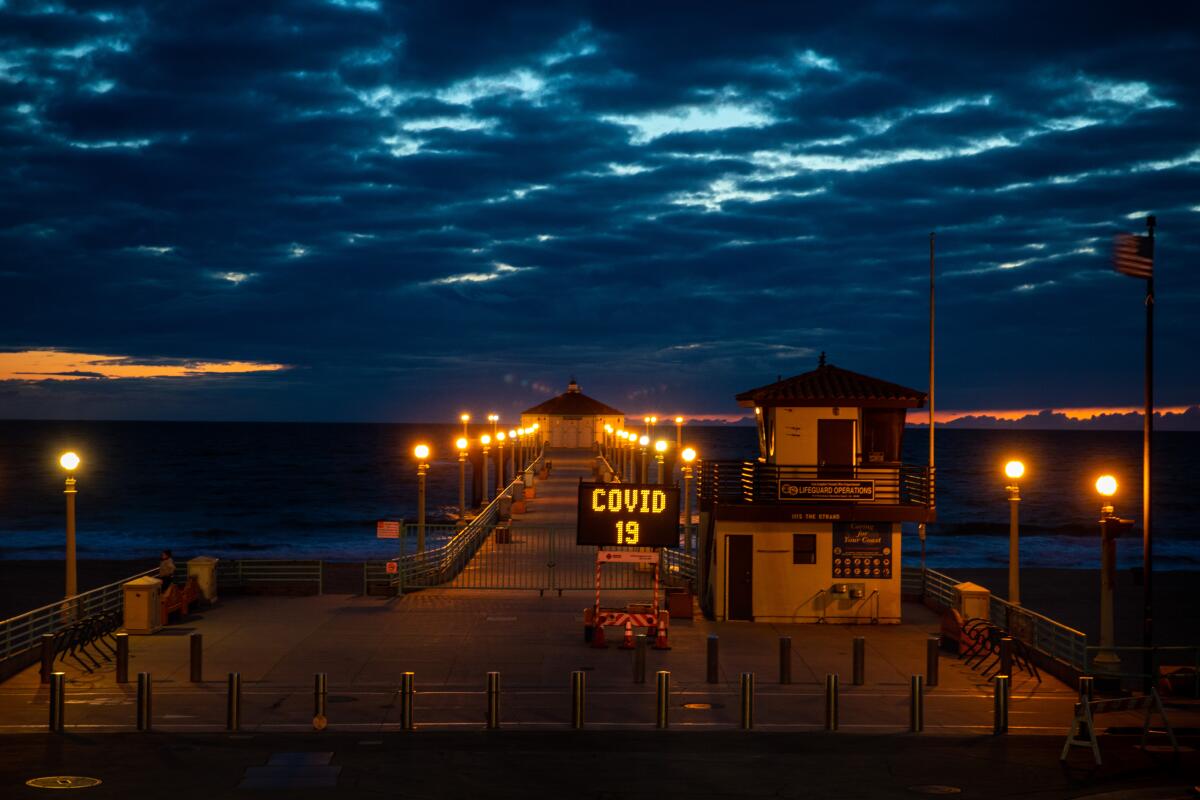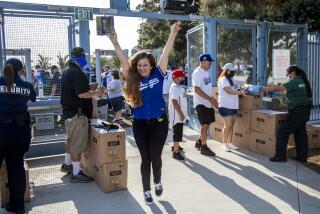‘These are not numbers, these are neighbors,’ Garcetti says as coronavirus cases surge in L.A.

Californians completed their first full week under orders to stay at home Thursday, as grim statistics mounted in the coronavirus outbreak: Confirmed cases in Los Angeles County rose by more than half in a single day, reaching 1,200. Nine new deaths were reported in the county, bringing the virus’s toll to 21.
“Even more disturbingly, we see that if this rate of increase continues, in six days, we will be where New York is today, the same number of cases per capita as they are struggling through,” Los Angeles Mayor Eric Garcetti said during a somber online briefing Thursday evening.
That is not a record any city wants to break. And it is, he said, more than just a figure.
“These are not numbers, these are neighbors,” Garcetti said. “There is no projection in which a couple weeks from now, we’re doing fine. This will be tough.”
The number of coronavirus cases in California surged past 4,000 by Thursday evening, and the state’s death toll hit 83. Experts warn that such a growth rate could overwhelm hospitals in coming days.
New York, which has become the national epicenter of the coronavirus crisis, has had 285 deaths, more than three times as many as California. But officials said California needs to brace itself for far more cases and deaths soon.
Nicholas Jewell, a biostatistics researcher at UC Berkeley who has been tracking the pandemic, said COVID-19 is spreading rapidly throughout the U.S., at a rate quicker than or on par with countries hit the hardest.
While California continues to try to gain a clear picture of the outbreak, Jewell said, the expected surge does not mean physical distancing and shelter-in-place orders aren’t working.
“We knew going in we will not see any impact of shelter in place for at least two to three weeks,” he said. “We have to be patient at this point and stay the course.”
President Trump took a more sanguine tone Thursday in a letter to governors — a further sign that he is eager to relax federal guidelines on school closures and limiting social gatherings to boost the stalled economy. Public health experts have warned that he is moving prematurely and that there is not enough information to show the pandemic’s progress has slowed.
“There is still a long battle ahead, but our efforts are already paying dividends,” Trump wrote. “As we enhance protections against the virus, Americans across the country are hoping the day will soon arrive when they can resume their normal economic, social and religious lives.”
That day does not seem to be coming any time soon in California.
San Bernardino County recorded 55 COVID-19 cases and three fatalities from the virus Thursday. The number of confirmed cases has tripled in less than a week; on Monday, there were only 17. The deaths include two men, ages 50 and 46, with underlying health conditions.
In Riverside County, 197 COVID-19 cases were confirmed as of Thursday. So far this month, eight people have died because of the virus, said county spokeswoman Brooke Federico. All were age 70 or older, she said, and some had underlying health issues.
As the outbreak worsens, two federal medical stations will open in Riverside County to relieve stress on area hospitals that are preparing for an influx of cases. Members of the National Guard began work Wednesday on one of the temporary medical facilities at the county fairgrounds in Indio. A second location has not been confirmed, Federico said.
San Francisco leaders said Wednesday that their city could face a New York-sized crisis — falling short 1,500 ventilators and 5,000 hospital beds. Said Mayor London Breed: “It’s not even a question as to whether we will need more.”
The virus — and efforts to halt its spread — have caused another California casualty, officials said Thursday: Stay-at-home orders and physical distancing have resulted in drastic drops in public transit ridership and cuts in availability.
As of March 20, Metrolink ridership was down roughly 80% across the system, which includes routes connecting Los Angeles, Orange, Riverside, San Bernardino, San Diego and Ventura counties. This week that drop-off plunged to 85%, system officials said, with daily boardings falling from an average of 43,000 to 6,292.
As a result, Metrolink has cut train service by 30%, said chief executive Stephanie Wiggins. The new schedule was effective Thursday and will last for the foreseeable future. It maintains peak-time routes and as many connections as possible for riders, she said.
“We take seriously our role as a lifeline transportation service for our community,” Wiggins said. “We also take seriously the need to keep both our riders and employees safe during this global pandemic.”
The L.A. County Metropolitan Transportation Authority is reducing bus service 15% to 20% and running trains less frequently. The Bay Area Rapid Transit system is operating on an abridged schedule, shutting down at 9 p.m., three hours earlier than normal.
And among San Francisco’s transit cuts is one that will sadden young riders and those who are young at heart: The little cable cars have stopped running halfway to the stars.
As anyone who has visited Los Angeles International Airport has noticed, air traffic also has taken a huge hit. LAX air passenger traffic is down 85%, Sean Burton, president of the Los Angeles Board of Airport Commissioners, said at a commission meeting Thursday.
That has rippled out into a 50% drop in concession revenues, an 80% decrease in rental car transactions and a 60% fall in duty-free revenues.
“Clearly,” Burton said, “the magnitude of what we are facing is immense.”
Times staff writers Kailyn Brown, Dakota Smith, Laura J. Nelson, Priscella Vega, Chris Megerian, Anita Chabria and Luke Money contributed to this report.
More to Read
Sign up for Essential California
The most important California stories and recommendations in your inbox every morning.
You may occasionally receive promotional content from the Los Angeles Times.














